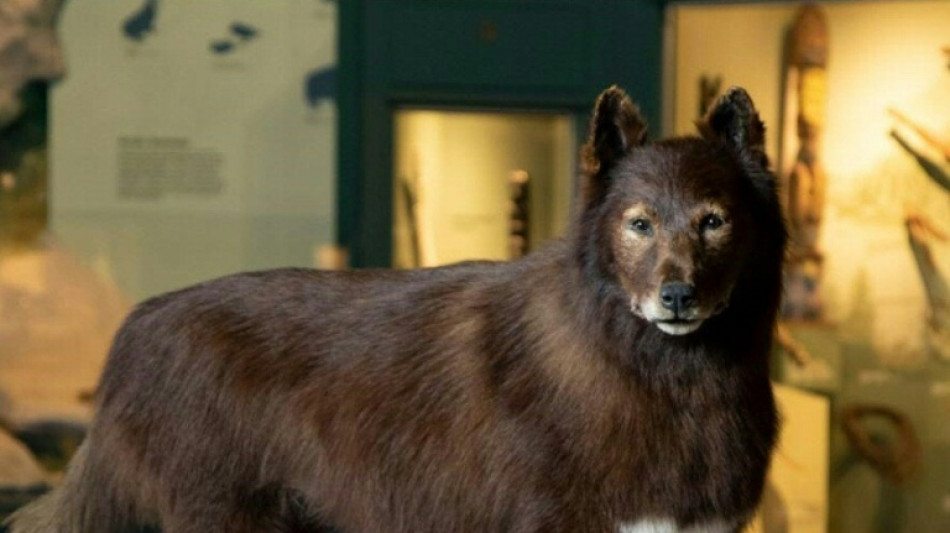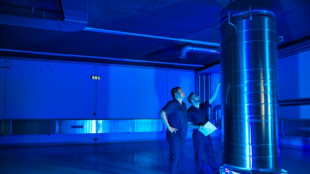
-
 Markets mixed after Wall St losses as traders weigh US rates outlook
Markets mixed after Wall St losses as traders weigh US rates outlook
-
Law and disorder as Thai police station comes under monkey attack

-
 Philippines cleans up as typhoon death toll rises
Philippines cleans up as typhoon death toll rises
-
Long delayed Ukrainian survival video game sequel set for release amid war

-
 Philippines cleans up after sixth major storm in weeks
Philippines cleans up after sixth major storm in weeks
-
Markets swing after Wall St losses as traders weigh US rates outlook

-
 Gabon early results show voters back new constitution
Gabon early results show voters back new constitution
-
Is AI's meteoric rise beginning to slow?

-
 Biden touts climate legacy in landmark Amazon visit
Biden touts climate legacy in landmark Amazon visit
-
Biden clears Ukraine for long-range missile strikes inside Russia

-
 'Nobody can reverse' US progress on clean energy: Biden
'Nobody can reverse' US progress on clean energy: Biden
-
Biden allows Ukraine to strike Russia with long-range missiles: US official

-
 Biden clears Ukraine for missile strikes inside Russia
Biden clears Ukraine for missile strikes inside Russia
-
Ukrainians brave arduous journeys to Russian-occupied homeland

-
 'Devil is in the details,' EU chief says of S.America trade deal
'Devil is in the details,' EU chief says of S.America trade deal
-
Toll in Tanzania building collapse rises to 13, survivors trapped

-
 'Red One' tops N.America box office but could end up in the red
'Red One' tops N.America box office but could end up in the red
-
Biden begins historic Amazon trip amid Trump climate fears

-
 Macron defends French farmers in talks with Argentina's Milei
Macron defends French farmers in talks with Argentina's Milei
-
India and Nigeria renew ties as Modi visits

-
 Typhoon Man-yi weakens as it crosses Philippines' main island
Typhoon Man-yi weakens as it crosses Philippines' main island
-
迪拜棕榈岛索菲特美憬阁酒店: 五星級健康綠洲

-
 The Retreat Palm Dubai MGallery by Sofitel: Пятизвездочный велнес-оазис
The Retreat Palm Dubai MGallery by Sofitel: Пятизвездочный велнес-оазис
-
The Retreat Palm Dubai MGallery by Sofitel: A five-star wellness Oasis

-
 Power cuts as Russian missiles pound Ukraine's energy grid
Power cuts as Russian missiles pound Ukraine's energy grid
-
Biden in historic Amazon trip as Trump return sparks climate fears

-
 India hails 'historic' hypersonic missile test flight
India hails 'historic' hypersonic missile test flight
-
Debt-saddled Laos struggles to tame rampant inflation

-
 India's vinyl revival finds its groove
India's vinyl revival finds its groove
-
Climate finance can be hard sell, says aide to banks and PMs

-
 Egypt's middle class cuts costs as IMF-backed reforms take hold
Egypt's middle class cuts costs as IMF-backed reforms take hold
-
Dinosaur skeleton fetches 6 million euros in Paris sale

-
 Trump's Republican allies tread lightly on Paris pact at COP29
Trump's Republican allies tread lightly on Paris pact at COP29
-
China's Xi urges APEC unity in face of 'protectionism'

-
 Farmers target PM Starmer in protest against new UK tax rules
Farmers target PM Starmer in protest against new UK tax rules
-
UN climate chief urges G20 to spur tense COP29 negotiations

-
 Philippines warns of 'potentially catastrophic' Super Typhoon Man-yi
Philippines warns of 'potentially catastrophic' Super Typhoon Man-yi
-
Tens of thousands flee as Super Typhoon Man-yi nears Philippines

-
 Gabon votes on new constitution hailed by junta as 'turning point'
Gabon votes on new constitution hailed by junta as 'turning point'
-
Tens of thousands flee as Typhoon Man-yi nears Philippines

-
 Is Argentina's Milei on brink of leaving Paris climate accord?
Is Argentina's Milei on brink of leaving Paris climate accord?
-
Fitch upgrades Argentina debt rating amid economic pain

-
 Trump picks Doug Burgum as energy czar in new administration
Trump picks Doug Burgum as energy czar in new administration
-
At summit under Trump shadow, Xi and Biden signal turbulence ahead

-
 Xi warns against 'protectionism' at APEC summit under Trump cloud
Xi warns against 'protectionism' at APEC summit under Trump cloud
-
Xi, Biden at Asia-Pacific summit under Trump trade war cloud

-
 Leftist voices seek to be heard at Rio's G20 summit
Leftist voices seek to be heard at Rio's G20 summit
-
Boeing strike will hurt Ethiopian Airlines growth: CEO

-
 US retail sales lose steam in October after hurricanes
US retail sales lose steam in October after hurricanes
-
Spate of child poisoning deaths sparks S.Africa xenophobia


DNA study of famed US sled dog shows what made him so tough
New York's Central Park has a statue dedicated to him, and there's even been a movie about him: a sled dog named Balto. Now he is the focus of a DNA study, 90 years after he died, to see what made the pooch so famously tough.
In 1925, this Siberian husky was part of an expedition in Alaska called the serum run, the goal of which was to bring life-saving medicine to young people in the remote town of Nome that were threatened by diphtheria.
The mission in horrendous blizzards conditions involved a series of sled dog teams transporting the anti-toxin relay-style from the city of Anchorage. Balto led the dog team that covered the last stretch of the grueling journey.
The dog died in 1933, and its mounted body has been on display at the Cleveland Museum of Natural History ever since.
"Balto’s fame and the fact that he was taxidermied gave us this cool opportunity 100 years later to see what that population of sled dogs would have looked like genetically and to compare him to modern dogs," said Katherine Moon, a postdoctoral researcher at the University of California, Santa Cruz and the main author of the study.
It was published Thursday in the journal Science.
Her team took skin samples from the dog's belly and reconstructed its genome -- the complete set of genes in an organism.
They compared this genetic material with that of 680 contemporary dogs from 135 breeds.
Contrary to a legend that held that Balto was half wolf -- as suggested in an animated Universal Pictures film that came out in 1995 -- this analysis found no evidence he had wolf blood.
It turned out Balto shared ancestors with modern day Siberian Huskies and the sled dogs of Alaska and Greenland.
Zoom's team also compared Balto's genes with the genomes of 240 other species of mammals as part of an international effort called the Zoonomia Project.
This allowed researchers to determine which DNA fragments were common across all those species and have not therefore changed over the course of millions of years of evolution.
This stability suggests that these stretches of DNA are associated with important functions in the animal, and that mutations there could be dangerous.
The bottom line from the research was that Balto had fewer potentially dangerous mutations than modern breeds of dogs did, suggesting he was healthier.
"Balto had variants in genes related to things like weight, coordination, joint formation and skin thickness, which you would expect for a dog bred to run in that environment," Moon wrote in a statement.
C.Peyronnet--CPN



